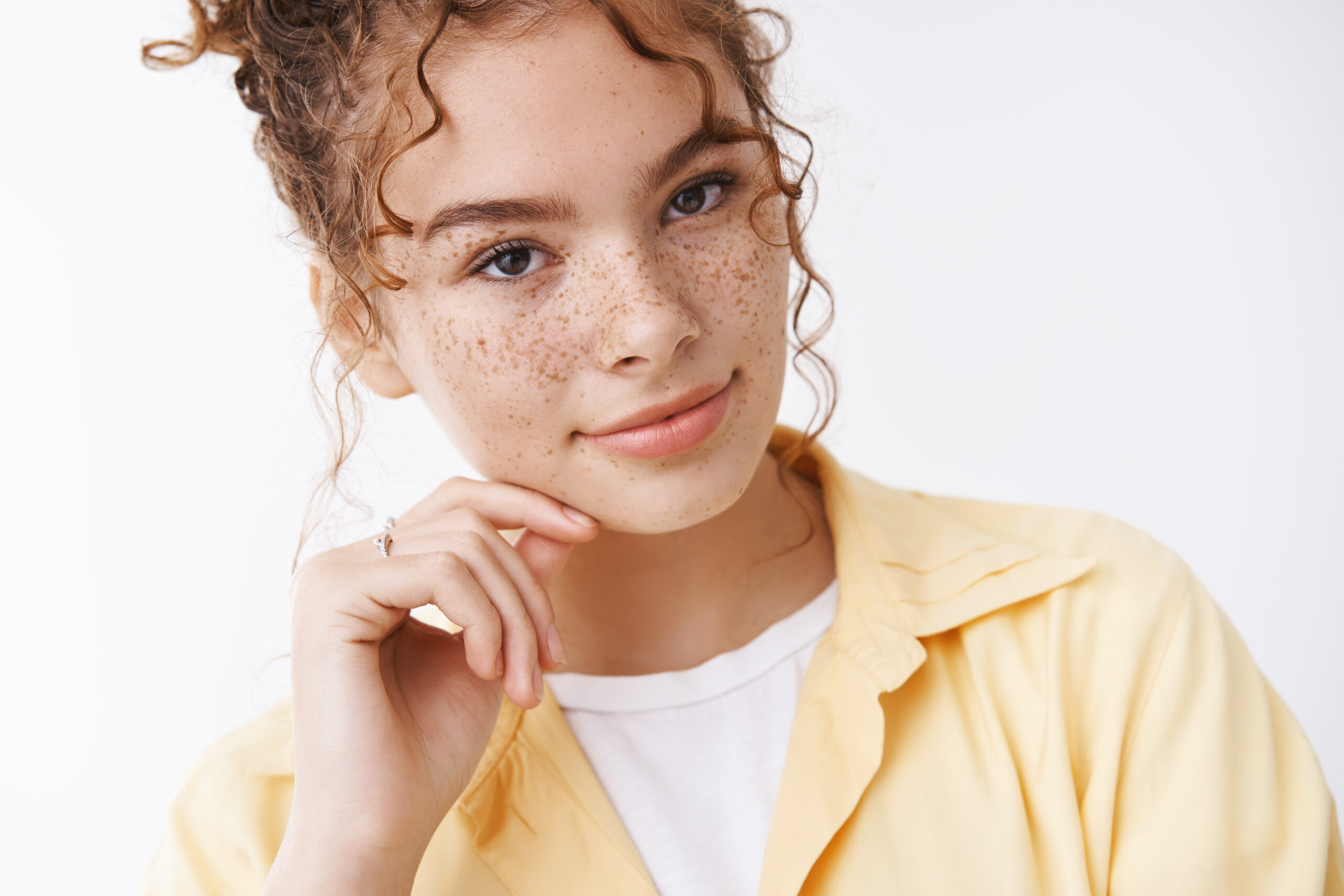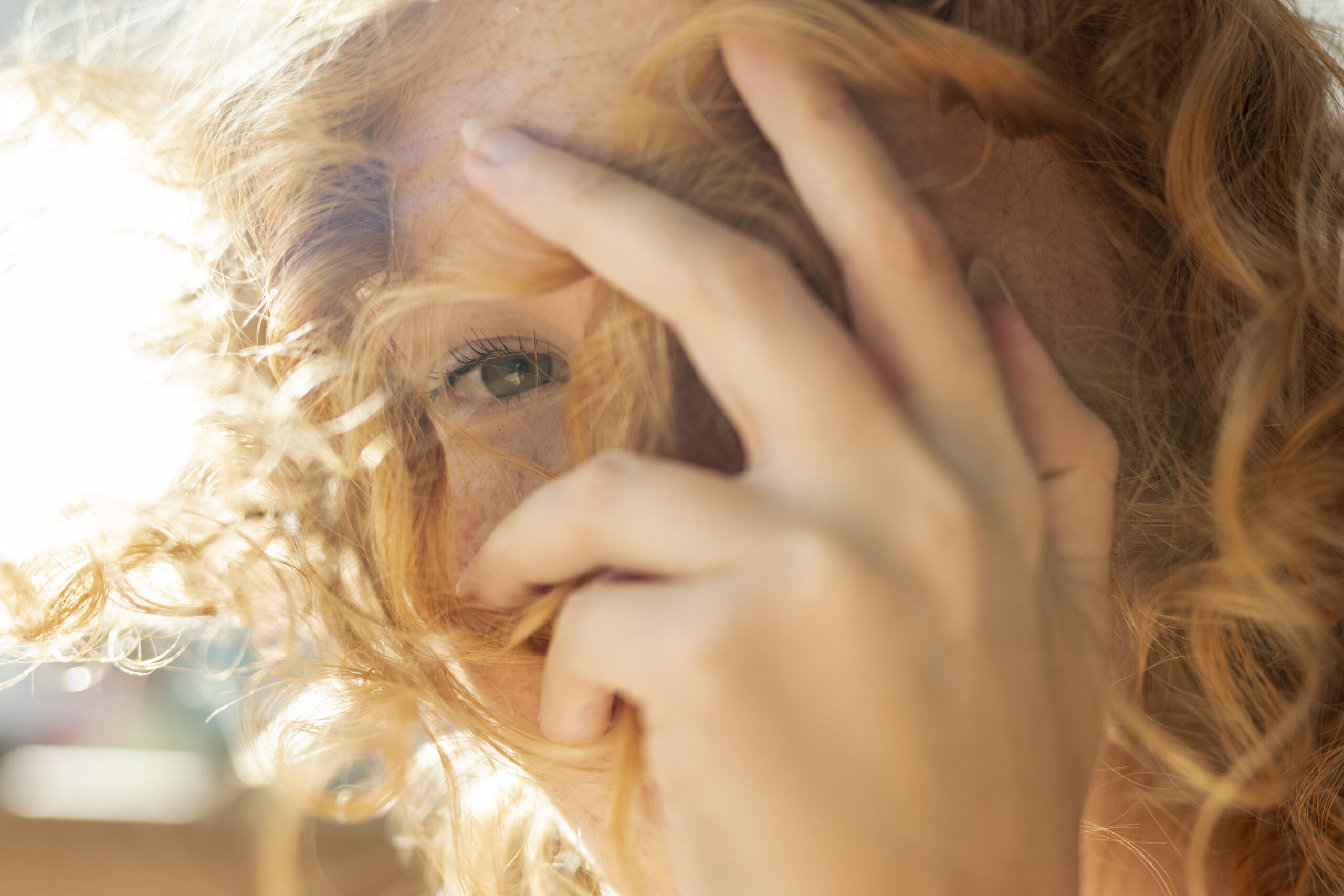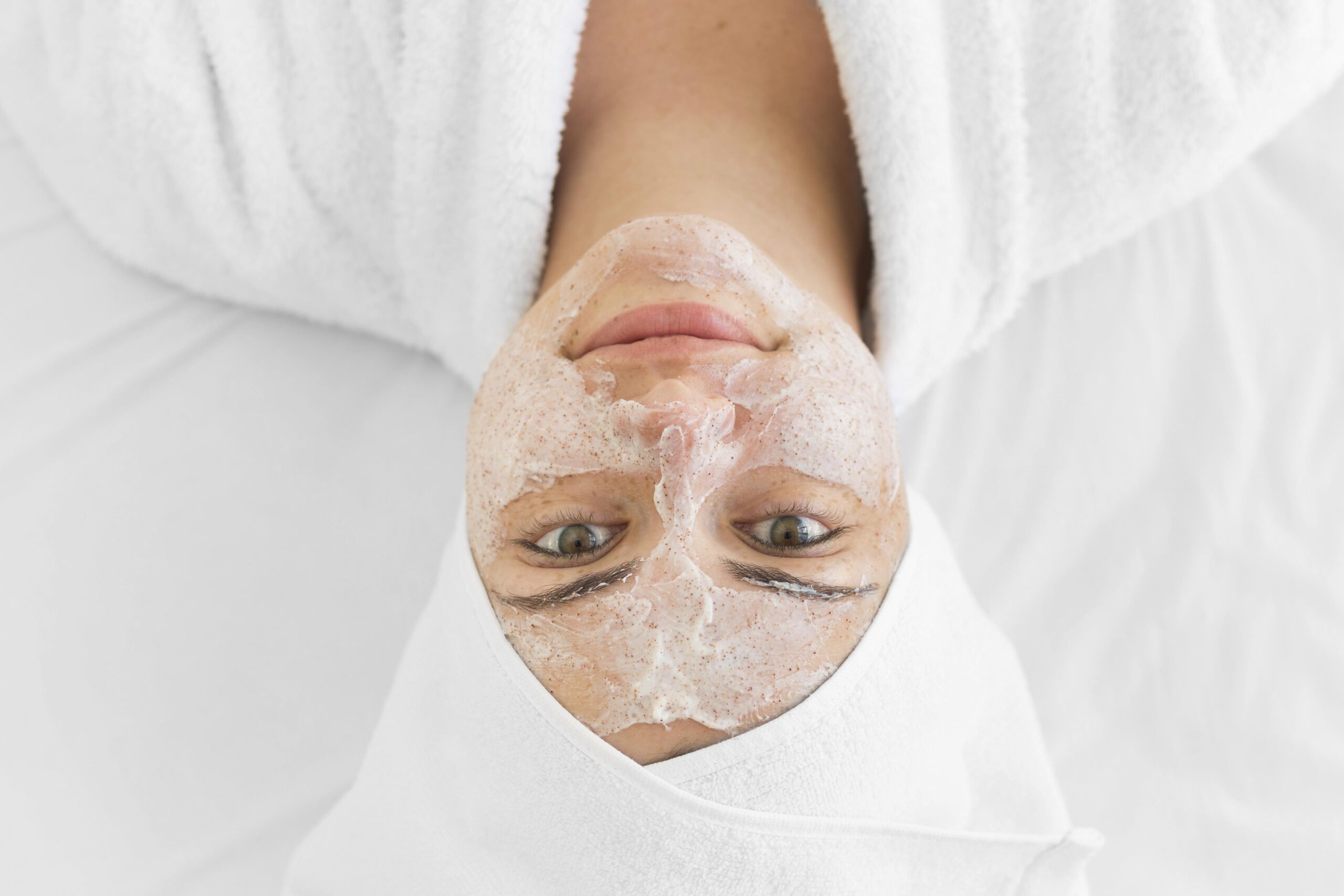Freckles are small areas of heightened pigmentation on the skin due to the accumulation of melanin. They are commonly flat, brown, or light brown single spots or happen in clusters.
Freckles![]() are on exposed parts of the body. They are visible primarily on:
are on exposed parts of the body. They are visible primarily on:

Brown spots on the skin have different origins, and there are several types of skin pigmentation changes:
Lentigines![]() , commonly known as liver spots, are pigmented lesions that surpass the size and darkness of freckles. Their development is linked to an augmented production of skin pigment and an upsurge in melanocyte proliferation. These blemishes become apparent in early childhood and can manifest across the entire body and mucous membranes. Solar lentigines, in particular, are associated with exposure to ultraviolet radiation.
, commonly known as liver spots, are pigmented lesions that surpass the size and darkness of freckles. Their development is linked to an augmented production of skin pigment and an upsurge in melanocyte proliferation. These blemishes become apparent in early childhood and can manifest across the entire body and mucous membranes. Solar lentigines, in particular, are associated with exposure to ultraviolet radiation.
The occurrence of age spots![]() , a form of lentigines, is prevalent among individuals aged 40 and above. These spots result from the natural aging process, characterized by an increased production and accumulation of melanin and melanocytes in the skin.
, a form of lentigines, is prevalent among individuals aged 40 and above. These spots result from the natural aging process, characterized by an increased production and accumulation of melanin and melanocytes in the skin.
Chloasma![]() is often discolored in the middle of the face – above the upper lip, on the chin, cheeks, forehead, and nose. These are ill-defined brown spots on the skin. Chloasma on the face occurs practically only in women. This is related to hormonal factors (use of oral contraceptives and pregnancy).
is often discolored in the middle of the face – above the upper lip, on the chin, cheeks, forehead, and nose. These are ill-defined brown spots on the skin. Chloasma on the face occurs practically only in women. This is related to hormonal factors (use of oral contraceptives and pregnancy).
Chloasma may appear as a result of exposure to UV radiation but also after taking phototoxic or photoallergic agents (people with thyroid diseases and ovarian tumors use them).
Post-inflammatory hyperpigmentation![]() manifests in various sizes and shapes, often appearing in areas previously affected by inflammation. Inflammation may stem from diverse skin conditions or injuries, such as improper manual cleansing or treatments that excessively disrupt the skin tissue.
manifests in various sizes and shapes, often appearing in areas previously affected by inflammation. Inflammation may stem from diverse skin conditions or injuries, such as improper manual cleansing or treatments that excessively disrupt the skin tissue.
Individuals with darker skin tones may experience more pronounced post-inflammatory discoloration. This hyperpigmentation type frequently lingers even after the initial cause has resolved, resulting in long-term dark spots on the skin, lasting for months or even years.
Freckles typically stem from genetic factors, often inherited from parents and other family members. Additionally, prolonged and regular exposure to sunlight contributes to the development of darker-pigmented spots on the skin.
It is essential to understand the origins of freckles![]() , as they arise from irregular distribution of the pigment on the skin. When the skin pigment melanin accumulates unevenly and excessively in specific areas, freckles form.
, as they arise from irregular distribution of the pigment on the skin. When the skin pigment melanin accumulates unevenly and excessively in specific areas, freckles form.
Sunspots![]() appear especially in spring and summer when exposed body parts are exposed to sun and light more often and willingly. Sun rays penetrate the skin and stimulate melanocytes, which in turn leads to the appearance of skin discolorations and their increase and darkening. Small spots mainly decorate the most exposed areas of the body, i.e., the face, neck, cleavage, arms, and upper back.
appear especially in spring and summer when exposed body parts are exposed to sun and light more often and willingly. Sun rays penetrate the skin and stimulate melanocytes, which in turn leads to the appearance of skin discolorations and their increase and darkening. Small spots mainly decorate the most exposed areas of the body, i.e., the face, neck, cleavage, arms, and upper back.
It is worth knowing that people with fair skin, i.e., those prone to skin discoloration, are more susceptible to sunburn and squamous cell or basal cell skin cancer.

Freckles caused by the sun may disappear spontaneously even a few or a dozen or so weeks after the end of the holiday season, i.e., exposure of the body to the sun. Sometimes, however, they will only fade away but will remain a permanent decoration of the face or other body parts on which they appeared.
It turns out that freckles do not have to appear after sunbathing. All you need to do is implement appropriate prevention.
Freckles result from the excessive accumulation of melanin![]() , a water-insoluble organic pigment, in the epidermal cells, causing discoloration. Melanin is produced through melanogenesis from the amino acid tyrosine via oxidation and condensation, primarily in melanocytes. There are two types of melanin – black eumelanin and red pheomelanin – regulated by melanotropic hormone. Melanocytes, found in the basal layer of the epidermis, store the pigment in specialized cell organelles called melanosomes.
, a water-insoluble organic pigment, in the epidermal cells, causing discoloration. Melanin is produced through melanogenesis from the amino acid tyrosine via oxidation and condensation, primarily in melanocytes. There are two types of melanin – black eumelanin and red pheomelanin – regulated by melanotropic hormone. Melanocytes, found in the basal layer of the epidermis, store the pigment in specialized cell organelles called melanosomes.
The formation of freckles, characterized by mild skin discoloration, is primarily influenced by genetic predispositions, sunlight exposure, skin inflammation, certain medications, and hormonal changes. Freckles occur due to an overproduction of melanin by a standard number of melanocyte cells, often associated with autosomal dominant disorders.
The presence of brown spots on the body is harmless. Freckles are benign lesions that do not need to be removed. If someone decides to remove them, it is only for aesthetic reasons.
For some people, freckles are a charming decoration of the face and body that distinguishes them from others, and they enjoy their presence. However, others consider freckles a disfiguring defect and dream of having them removed. They are targeted by in-office and home methods that lighten, reduce the visibility of freckles, and even remove them. These include chemical methods, i.e., acid peels, creams, brightening preparations, and physical methods, such as laser therapy.
Chemical peels![]() are a professional treatment that effectively reduces the visibility of freckles. These peels promote exfoliation of the epidermis and facilitate the penetration of active substances into the skin. When combined with depigmentation agents, they inhibit melanin synthesis and tyrosinase activity while acidifying the skin environment to enhance their therapeutic effectiveness.
are a professional treatment that effectively reduces the visibility of freckles. These peels promote exfoliation of the epidermis and facilitate the penetration of active substances into the skin. When combined with depigmentation agents, they inhibit melanin synthesis and tyrosinase activity while acidifying the skin environment to enhance their therapeutic effectiveness.
For the safe and effective administration of chemical peels, they must be performed by trained specialists such as cosmetologists, dermatologists, or aesthetic medicine doctors. Only with the careful selection of appropriate substances, their concentrations, pH levels, treatment duration, and frequency, along with considering contraindications and proper post-treatment care, can satisfactory results be achieved.
The following acids are utilized for various treatments:
Depigmenting agents![]() , specifically tyrosinase inhibitors effective in addressing freckles, encompass:
, specifically tyrosinase inhibitors effective in addressing freckles, encompass:
Freckles can be effectively removed using a laser![]() , the focused light of which selectively reaches the melanin in melanosomes and destroys them using thermal energy. As epidermal-type discoloration, freckles are easier to remove than dermal-type discoloration.
, the focused light of which selectively reaches the melanin in melanosomes and destroys them using thermal energy. As epidermal-type discoloration, freckles are easier to remove than dermal-type discoloration.
People with freckles also have many lightening preparations![]() available for home use. However, be patient when using them because the effects may appear only after many weeks of regular treatments.
available for home use. However, be patient when using them because the effects may appear only after many weeks of regular treatments.
Preparations for mitigating freckles at home encompass cosmetics, particularly lightening creams. Depending on the composition, the main mechanisms of their action are:
These effects are directly related to the properties of the active substances used to produce the serum.
It is essential to emphasize the significance of proper facial care![]() , regardless of whether one is contending with the manifestations of dry skin or addressing concerns associated with mature skin. The pivotal role in this regard is attributed to selecting appropriate cosmetics and the consistency and sequence of individual treatments.
, regardless of whether one is contending with the manifestations of dry skin or addressing concerns associated with mature skin. The pivotal role in this regard is attributed to selecting appropriate cosmetics and the consistency and sequence of individual treatments.
The main stage of daily facial skin care is its thorough cleansing. It's not just about removing makeup. When cleansing the face, we eliminate excess sebum, dust, dead skin, and everyday dirt. Micellar fluid is great for washing your face and removing makeup.
Natural toning with hydrolate or traditional tonic – it doesn't matter what you choose; the important thing is that you don't skip it. Cleansing cosmetics often disturbs our natural pH, so when caring for your face, it is worth remembering to restore it.
Taking care of a good level of hydration is crucial in daily care. Various types of cosmetics are used for this purpose. You can find different creams on the market. Some better, some worse. The composition must be as natural as possible. By choosing products with good composition, we provide our faces with good care. The cream can be applied after using the serum or instead of it.
The moisturizing cream prevents water loss from cells and “replaces” our natural sebum production. It means that if the skin is not moisturized enough, our skin will start to moisturize itself from the inside. This may make it appear oily and give us gifts in the form of blackheads and blackheads.
In the morning, it is worth choosing creams enriched with SPF, i.e., creams with a filter. Such products protect our skin against the harmful effects of sunlight, loss of firmness, and cancer. Contrary to appearances, sunscreen should be used all year round, not only when we see great, sunny weather outside.
Getting rid of dead skin is called exfoliation. Do it regularly, but not every day. We perform peelings on average twice a week. For this purpose, we can choose coarse-grained or enzymatic peeling – depending on our skin type. Sensitive and problematic skin is too delicate to use a typical peeler, so specialists recommend enzyme peels as they penetrate the skin's surface and smooth it from the inside.
A healthy-looking face is not only about expensive facial cosmetics and well-selected facial care. It depends on many factors, such as a good diet, drinking enough water, and getting enough sleep. Let's take care of our face, mind, and body.

You can use eye shadow, eyebrow paste, eyeliner, bronzer, eyebrow pencil, marker, or mascara. Artificial freckles can be applied with a thin, wet brush or a silicone applicator with a very fine tip, but some people use sponge applications.
It is worth taking a few tips to heart to make artificial freckles look natural. First, fake freckles should blend in with your skin tone. A golden-brown product is best for creating artificial freckles. We do not make black dots on the face because they could resemble blackheads and not cute freckles.
Secondly, we place the dots on the face (on the nose and cheeks near the nose and between the eyebrows on the forehead) quite irregularly, imitating natural sun spots as best as possible.
Thirdly, to make artificial freckles look natural, it is worth tapping them lightly with your fingertip or a sponge after applying them to blend the edges. Thanks to this, artificial freckles will blend better with your skin tone.
To make artificial freckles visible and lasting well, we do them at the end of applying makeup, after applying foundation. You only need to brush them off with a powder brush or spray your face with a makeup fixer to fix the artificial freckles.
Henna – like other products for creating artificial freckles – also needs to be chosen to match your skin tone and resemble sun spots. A cosmetic in a natural copper shade will work best. Henna usually needs some time to oxidize and take on the right shade on the skin. Applying it in the evening is best to enjoy the beautiful shade of artificial freckles the next day.
Remember not to place the dots too symmetrically when applying artificial freckles with henna. Moreover, where we want freckles to be most visible – around the nose – you need to apply more product there.
After applying henna, which has a slightly liquid consistency, you need to wait about 20 minutes until it dries and wash off the excess with a cotton pad soaked in water. There should be golden-brown dots on the face, i.e., artificial freckles, which will acquire the appropriate “natural” color over time.
If you want to make artificial freckles with henna, first do an allergy test. Some preparations may contain paraphenylenediamine (PPD), an aromatic amine that may cause allergies.